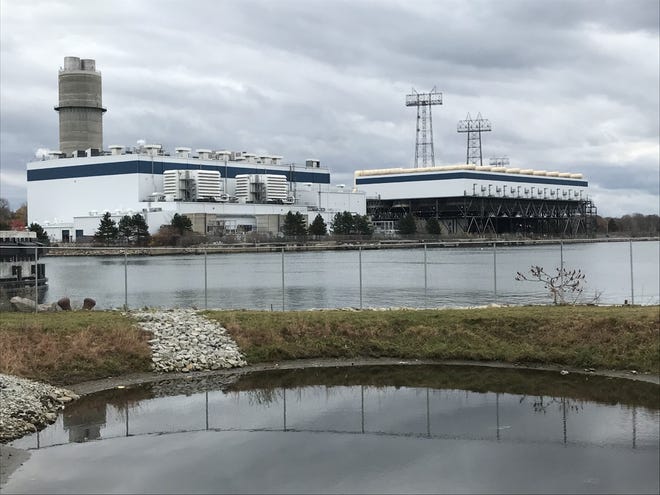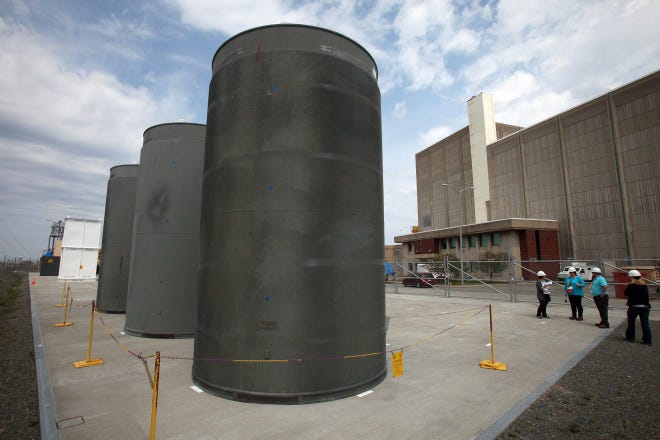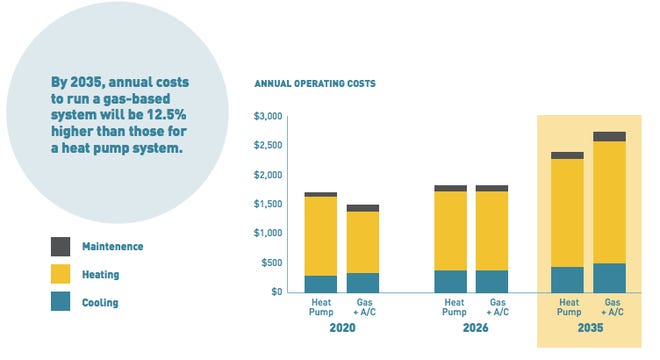When nuclear power plants close, greenhouse gas emissions increase. Why you should care.
Published March 10, 2022
An energy void left by the closure of Massachusetts' only nuclear power plant has been filled largely by natural gas – a reality hugely counteractive to much of New England's ambitious climate goals to slash emissions and reduce dependance on fossil fuels.
Data from the Environmental Protection Agency shows emissions from New England's power plants have altogether increased since the Pilgrim Nuclear Station in Plymouth closed in 2019 due to financial and safety reasons.
Power plants that burn fossil fuels – like natural gas, oil and coal – yield greenhouse gases, the dominant cause of global warming.
The rise in power plant emissions is certainly contrary to aggressive efforts to change course as Mother Nature's clock ticks – in a region that's warming faster than the rest of the nation and seeing sea levels rise faster than the global rate.
But experts caution that a singular dataset as such – depicting a short-term increase –should be considered within the entire picture of emission reductions across several sectors.
Nuclear plants don't burn fuel, which means they don't produce greenhouse gas emissions. But nuclear power comes with its own risks, as demonstrated most recently by Ukraine's nuclear plant fire last week that caused widespread concern, and more locally, a plan to dump radioactive waste from the decommissioned Pilgrim plant into Cape Cod Bay.
NOAA:New England's temps are warming, sea levels rising faster than the global rate
Since the Pilgrim Nuclear Station's closure, New England – a region already reliant on natural gas – has been using even more of it. Power plants, both new and existing, worked to fill the gap and ultimately released more emissions into the environment.
"When you close a nuclear plant, what's going to take its place is natural gas," said Howard Herzog, senior research engineer at the MIT Energy Initiative. "What's going to replace (gas) is getting more renewables, and that hasn't been coming in as fast as needed to make the stated goals. It needs to really accelerate."

Last year, Massachusetts Gov. Charlie Baker signed landmark climate legislation holding the state to a statutory commitment of cutting emissions in half by 2030 and then reaching net zero by 2050. All other New England states – except New Hampshire – also have statutory climate goals in place.
Vineyard Wind:The nation's first utility-scale wind farm is being built off Cape Cod
But experts like Herzog say the prolonged time it's taking to develop renewables like offshore wind, solar and hydropower could make it especially arduous for Massachusetts and its neighbors to meet their goals.
"Aggressive action literally needs to happen in the next eight years," said Kim Lundgren, CEO of Boston-based Kim Lundgren Associates, a benefit corporation that partners with towns and cities to implement climate solutions.
New England power plant emissions have increased
Both New England and the nation as a whole have seen overall success in reducing power plant emissions over the last two decades-plus, a 21% decrease in carbon dioxide emissions from 1995-2021.
But New England's numbers began to trend upward after the Pilgrim Nuclear Station closed in 2019, just as they did when Vermont Yankee Nuclear Power Station shut down in 2014. Pilgrim had provided Massachusetts with more than one-tenth of its electricity generation.

Entergy, which operated both plants, cited financial factors for the closure of Pilgrim, including low wholesale energy prices. Pilgrim first opened in the early 1970s, and its safety rating took a hit from the Nuclear Regulatory Commission in 2015.
Two nuclear plants in New England remain: in Connecticut and New Hampshire.
NRC:Seabrook, NH nuke plant ran safely in 2020, concrete degradation being monitored
According to the USA TODAY Network's analysis of EPA Clean Air Markets Division data, nearly half of reporting Massachusetts power plants saw a rise in carbon monoxide emissions between 2020 and 2021 – representing a more than 9% increase overall, or approximately 347,000 tons, when factoring in the power plants that saw decreases. The majority of power plants in Rhode Island, New Hampshire, Vermont, Maine and Connecticut also saw increases, the data showed.
As a region, EPA data shows all six New England states together saw an increase of 3% in total power plant emissions from 2019 to 2020, and then another increase from 2020 to 2021, the latter year still awaiting complete fourth-quarter data.
"It can be a short-term problem if we take the right action," said Cammy Peterson, director of clean energy for the Metropolitan Area Planning Council.
What's in your natural gas, Vermont?:'Digester' turns ice cream, beer and manure into fuel
At present, natural gas remains New England's dominant fuel source. According to Department of Energy statistics, natural gas fueled about 65% of Massachusetts' total in-state electricity net generation in 2020, and as of June 2021, the state had about 40% of the natural gas-fired generating capacity in New England, the largest share in the region.

This winter, with natural gas prices sky high, the region turned to oil – a much dirtier, lesser-used fuel – at an unprecedented rate not seen in recent years. At points this winter, oil accounted for 20-25% of power generation in New England.
Mike Steinhoff, director of climate analysis at Kim Lundgren Associates, said while a rise in power plant emissions is certainly not conducive to New England's climate goals, the change that needs to happen across all sectors is not going to occur at the same time.
"It's going to be a bumpy road," said Steinhoff. "When you look at the scale of the challenges for how much we have to electrify in buildings and transportation, you can't necessarily get hung up on (one thing). You have to keep your sights on the long-term."

Echoing similar sentiments, Ben Hellerstein, state director for policy and action group Environment Massachusetts, said he cautions against reading too much into a single-year emissions spike, for example.
"Year-to-year emissions data, it is important for us to keep an eye on those numbers," he said. "That being said, there can be fluctuations depending on weather and economic conditions."
What should have people's laser focus, Hellerstein contends, is "going big on solar and offshore wind," and the mass amounts of existing infrastructure that need to be retrofitted with energy-efficient tools.
New England renewable energy efforts moving slowly
Wind and solar power accounted for a record 13% of U.S. energy in 2021, said a report released last week, but advocates for renewable energy say New England isn't moving fast enough.
Efforts by Massachusetts and the region as a whole to establish renewable energy sources have been dealt some hefty blows over the last few years.
Last year, Maine voters killed a $1 billion proposal to build a 145-mile hydropower transmission line from Quebec to Massachusetts, a project that was attached to the very controversial Central Maine Power Co. New Hampshire regulators voted down a similar proposal back in 2018.

In Massachusetts, the nation's first full-scale utility wild farm – Vineyard Wind – experienced major project delays that set the construction date back for more than a year. The project, which is slated to be operational in 2024, now faces a handful of federal lawsuits.
Harnessing the wind:Massachusetts' offshore wind industry shows potential for job creation
"We need to be moving more quickly," said Peterson. "We don't have the time to waste treading water here. We're moving ahead on offshore wind, but it's very slow."
The Baker administration has committed to creating 5.6 gigawatts, the equivalent of seven Vineyard Wind 1 wind farms. Herzog cited "really big barriers moving ahead" in getting these projects built – political will being one of them.
Electricity is historically expensive for customers, but according to the Department of Energy, utility-scale wind is one of the lowest-priced energy sources available today, costing 1–2 cents per kilowatt-hour after the production tax credit.
A 2021 report by the Environment America Research and Policy Center and Frontier Group said Massachusetts' offshore wind potential is equal to more than 20 times the state's current electricity consumption.
How Massachusetts is trying to cut emissions elsewhere
Though its development of renewable energy sources may be moving slower than anticipated, Massachusetts is using a number of other mechanisms to try and decrease emissions in the meantime.
The state is placing major emphasis on financial incentives for residents and business owners to make the transition off natural gas and oil. Approved by the state Department of Utilities last month, a new three-year plan from Mass Save includes $4 billion in incentives for utility customers, a large chunk of which is dedicated to electric heat pump installation.

"It's not just up to the power producers to fix this problem," said Steinhoff. "We all have a role to play in how we consume this energy. The number of homes and cars and everything that has to be switched out, we've gotta get started now."
The state is also looking to apply incentives to new construction. The Department of Energy Resources earlier this month launched public hearings on its proposed building energy code that would offer incentives for builders to install electric heat.

However, the proposed code did not go as far as outlawing the continued use of fossil fuels. In a letter to DOER Commissioner Patrick Woodcock this month, Sens. Michael Barrett and Cynthia Creem wrote that the proposal "comes up short."
"For municipalities in Massachusetts and other progressive states, all-electric construction is the favored strategy for decarbonizing new buildings," they said.
Incentives:Massachusetts wants to pay you to convert to electric heat
A ruling from Attorney General Maura Healey in 2020 already proved to be a setback for communities looking to regulate fossil fuels in construction locally. Healey struck down an approved 2019 warrant article in Brookline that would have prohibited natural gas in new major construction, saying it conflicted with overriding state laws. Brookline has since persisted.

Hellerstein said his organization supports state policies that would mandate all new single-family homes built after 2025 be fossil fuel-free, as well as larger buildings by 2030.
"When you're in a hole, you have to stop digging," said Hellerstein. "We should today, immediately, stop investing in and building fossil fuel infrastructure in the state. New homes, buildings and schools should be fossil fuel-free."
ISO New England's role in renewable energy
Among barriers moving forward, says Greg Cunningham, vice president and program director for clean energy and climate change at the Conservation Law Foundation, is a perceived reluctance by ISO-New England to account for climate change in its mission and make way for the future of renewable energy in the region.
Most New England states – except New Hampshire – have legally binding climate goals in place. And yet, ISO-New England, the regional grid operator in charge of competitive wholesale markets, is "undermining" those goals with "outdated practices," Cunningham contends.
"It's absolutely absurd," said Cunningham. "Ninety percent of the demand in this region has climate mandates associated with it, and the ISO-New England refuses to build climate into its mission."

Matt Kakley, spokesperson for ISO-New England, said the organization "disagrees with that characterization," and feels it has done "a lot of work" to bring renewable energy sources into the market.
"We are focused on the clean energy transition and we are focused on our responsibility of keeping a reliable power system throughout that transition," said Kakley. "This is going to be a long-term effort from a lot of people needing to work together, and we consider ourselves partners in that."
Last month, in what was viewed as a blow to the renewable energy industry, ISO-New England announced its intent to transition out its "minimum offer price rule," known as MOPR, through 2025, instead of eliminating it next year as originally planned.
Gas prices:Russia's invasion of Ukraine is hitting local consumers at the gas pump
The MOPR takes heat from renewable energy advocates. They argue the rule prevents clean energy sources from placing successful low bids at ISO's annual power auction, and therefore, undercuts states' climate efforts.
Kakley said ISO-New England's transition will effectively remove the MOPR for up to 2,000 megawatts of state-sponsored renewable energy over the two-year period before the rule is completely eliminated in year three.
Most New England states have been opposed to the MOPR, but in a statement following ISO-New England's announcement, the New England States Committee on Electricity said it didn't oppose the delay, with New Hampshire as the exception.
The proposal is subject to review by the Federal Energy Regulatory Commission, which oversees ISO-New England.
‘People are dying’:Global warming already being seen in North America, UN report finds
Cunningham accused ISO-New England of favoring fossil fuel generators. But Kakley maintained that the organization doesn't have the authority "to look at the environmental attributes of resources when we are running our markets." It has advocated for carbon pricing, though unsuccessfully.
"We're bound by our federal regulator and the Federal Power Act," Kakley said. "We are required to run markets that are fuel- and technology-neutral, and that's what we do."

No comments:
Post a Comment
Note: Only a member of this blog may post a comment.